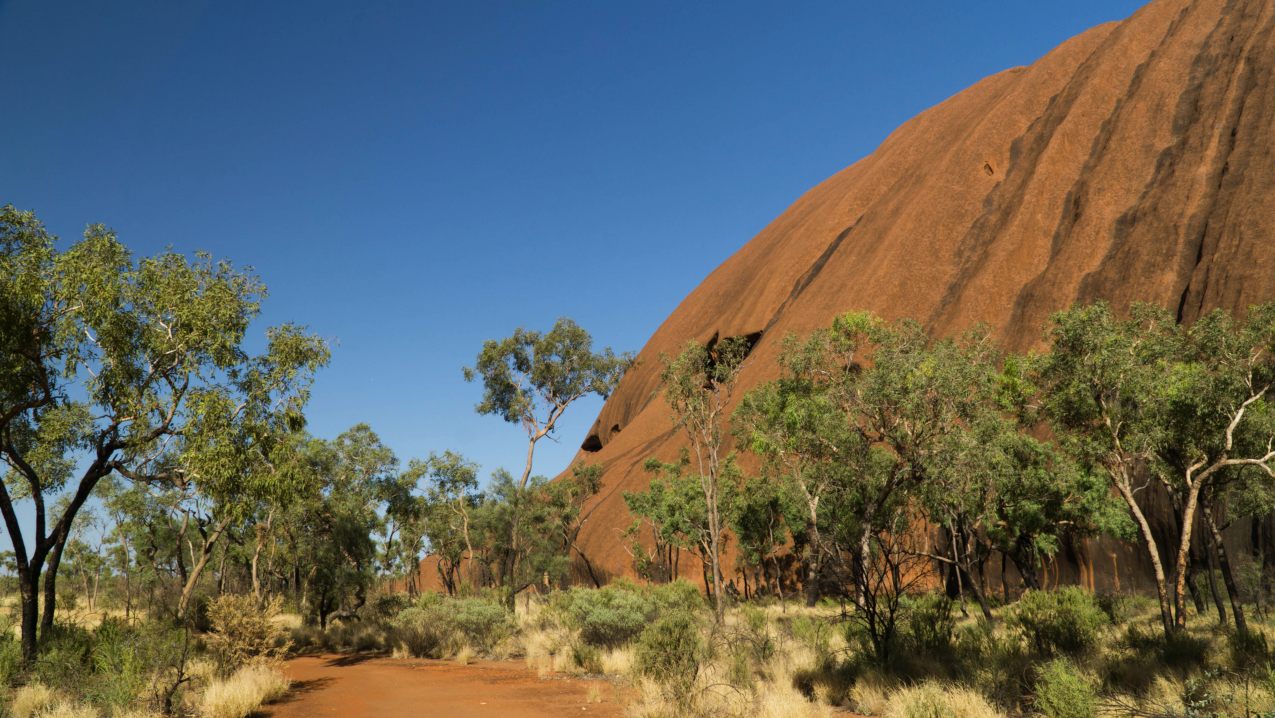Today we share everything we learned about the many walks at Uluru so you can work out which of these you should try to fit into your time here. In short, as many as you can!
This article may contain compensated links. Please read the disclaimer for more info.
Uluru is home to the Anangu (pronounced arn-ung-oo), Aboriginal people. They are said to have been on this land for more than 20,000 years, and the best way to experience this spiritual place is to walk its paths, slowly taking it all in.
If you are trying to decide whether to book an all inclusive package or do it yourself this guide to multi day tours in the Red Centre might help.
Please note: there are spots along the walk where photography is banned. These are clearly marked so please respect these sacred spaces.
Six Walks You Can Take at Uluru National Park
As we mention on our Uluru itinerary, we think it’s ideal if you visit the Cultural Centre the day you arrive, before you experience your first Uluru sunset.
Stop in at the information desk for maps and guides to all the walks we mention below, and if you can make the times work to join one of the free guided walks to learn more about the culture and history of Uluru.
A walk around this iconic site is eye-opening. While it’s likely, you have seen countless images of the monolith, it’s not until you get up close that you realise the surface is not flat but rather honeycomb-like with lots of nooks and crannies, each with their own Dreamtime stories.
Before you begin walking in Uluru
There are a few things we recommend:
- Wear a flynet or at the very least, take insect repellant with you
- Do not wear white shoes or pants; don’t even pack them. The red dust will stain.
- Carry at least two litres of water per person for the base walk.
- Use the facilities when you see them. The only bathroom is near the Mala car park.
- Sunscreen and a hat are highly recommended.
- If you walk in winter and start early in the day, it can be freezing, so dress appropriately
- Do not plan to be walking between 1.30pm and 6pm especially in summer
Please keep reading for our tips on the best way to see Uluru from one of its many tracks and which will suit your schedule and ability.
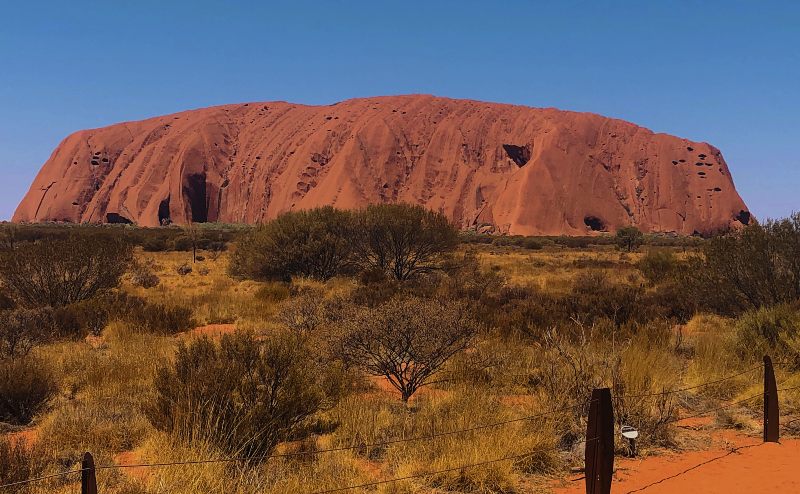
There are six walks to choose from at Uluru, graded 1-3, something for every fitness level here. A few of the trails are wheelchair and pram accessible in dry weather.
Uluru was added to the UNESCO list in 1987 for its natural features and 1994 for its cultural importance.
Uluru Base Walk – Highly Recommended
This is the walk we choose for our first full day at Uluru. By walking right around the rock, you can appreciate the size and beauty. The trail is 10.6km, but a few detours to caves and waterholes add a few extra kilometres. It took us about 3.5 hours.
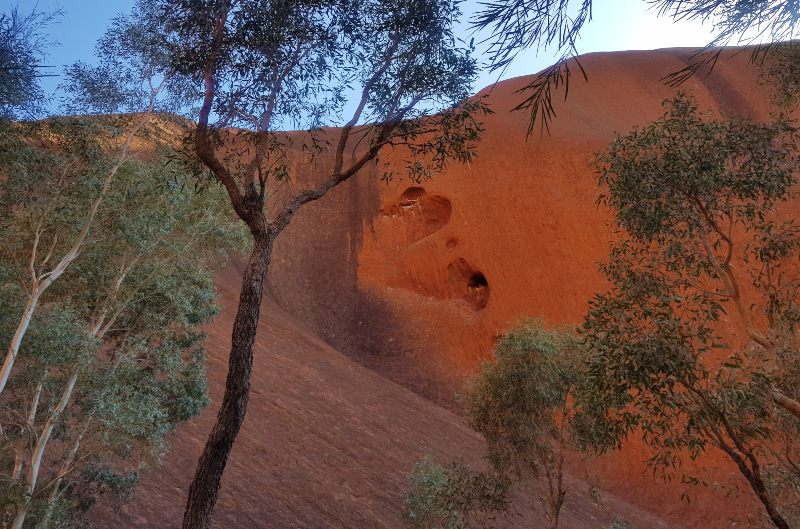
Ideally, you begin this walk nice and early – we intended to but did not set off until just before 9.45am. Rangers at the information desk in the cultural centre suggested that at this time of day that it is best to start from Kuniya car park and walk anti-clockwise around the base.
If you want to see Uluru’s waterfalls schedule your visit in the wet season (January to March)
Tip: Take a lot of water, much more than you think you need. There are two taps along the way, but the water was not very tasty!

If you start to walk just after sunrise, starting from the Mala car park is recommended.
Check out this free walk.
Difficulty: Grade 3 – I am not sure why this is a grade 3 – it’s flat and easy if you avoid the heat, it must be based on distance because it is not challenging.
Distance: 10.6km
Time to complete: 3.5hrs
Best for: Everyone who has the time, seriously, this is a brilliant walk.
Mala Walk
The Mala walk leads from Mala car park, where the Uluru summit walk began, to Kantju Gorge. While climbing is now banned, the scars of years of foot traffic on the rock are still visible. On this track, you see the North-West side of Uluru.
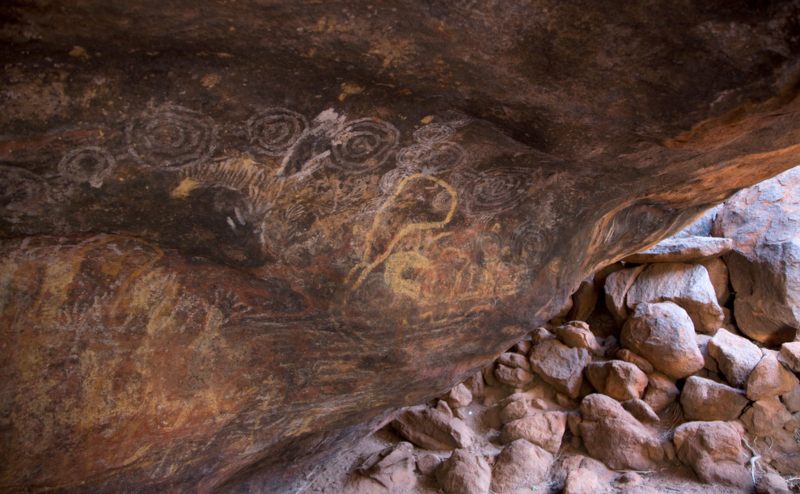
A free ranger-led walk leaves from here every morning at 8.00am (October-April), and 10.00am (May-Sept). If you can get along to this, it will add to your appreciation. The ranger gives an excellent insight into the meaning behind the art and the cultural traditions of the people who lived here.
Along with the rock art, Kulpi Nyiinkaku teaching cave is another highlight along the Mala walk.

The Mala Walk is an easy flat walk with plenty of rewards, including less of a crowd. This walk is the best for viewing Aboriginal rock art.
This is an excellent place to watch the sunset, particularly in winter; keep an eye out for Kantju Gorge for some great rock and sky contrasts.
Difficulty: Grade 1
Distance: 2km
Time to complete: 90 minutes – the ranger guided walk takes 2hrs
Tip: There are toilets across the road about 300m away. There are no more until you return.
The Kuniya Walk to Mutitjulu Waterhole
If you find you have slept in and woken to a stinking hot day, then this walk is an excellent choice. There is plenty of shade, and the stunning Mutitjula waterhole is a lovely finish. The walk explores the south side of Uluru.
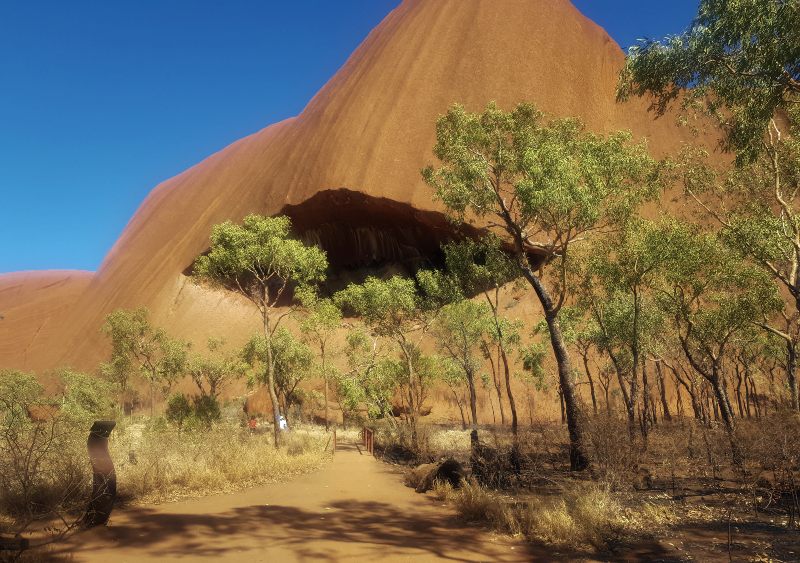
Mutitjulu Waterhole is one of a few permanent waterholes at Uluru. It is one of the most sacred areas here. If you are lucky to visit after rain, you may see water falling over the rock. If not, the dark stains you can see are where the waterfalls usually appear.
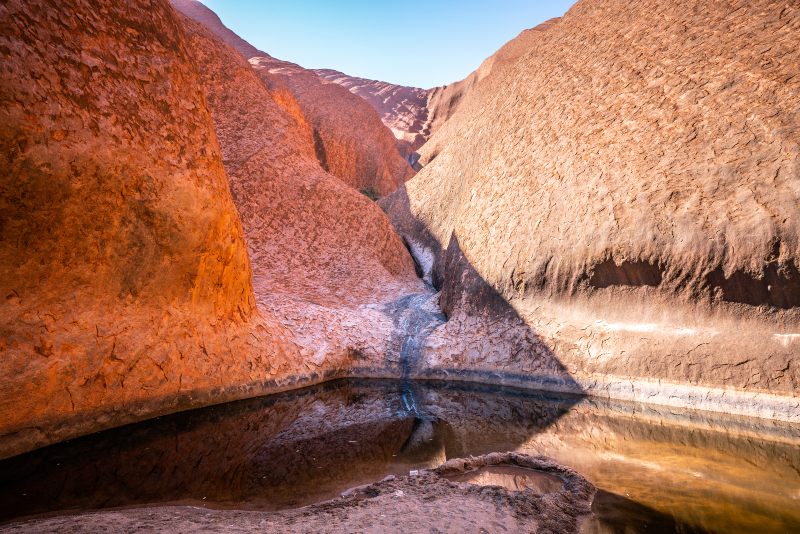
This is a superb walk for photographers as the diversity in this section of the rock is fantastic. From birds to the occasional wallaby, wildlife also congregates here because of the relative lushness of the vegetation.
Difficulty: Grade 1
Distance: 1km
Time to complete: 35 minutes
Tip: To miss the crowds, head straight after sunrise before any tour groups arrive.
Lungkata Walk
The Lungkata walk connects the Mala and Kuniya car parks. If you do this walk along with the Mala and Kuniya, you have covered the most exciting parts of the trail. There are many honeycomb-looking sections along this part of the trail, and the path passes very close, so you are right up next to it.
Difficulty: Grade 2
Distance: 4km
Time to complete: 90 minutes
Tip: This is a good spot to watch the sunset
Minymaku Walk & Watiku Walk
We had not intended to take these walks, but we were lucky enough to be at Uluru for the closing celebration of the Uluru summit climb. We arrived at the party located right by these walking tracks a couple of hours before the concert started, so we had a good wander here.
These two walks are the Minymaku Walk (Women’s Walk) and the Watiku Walk (Men’s Walk). Both are less than 1km long and a gentle stroll that allows you to learn more about the daily lives of the Anangu.

Getting around Uluru
By far, the best way to explore Uluru is with your own car, particularly for couples or groups. The other options are double the price. However, there are solutions if you choose not to rent a car for whatever reason.
Uluru Hop on Hop Off bus
We shared a car with friends on our visit, but a couple of others in our group used the shuttle service to Uluru. This is not to be confused with the free service that operates around the resort.
The Uluru HOHO offers either a return trip to the rock ($49), i.e. drop off and pick up from any of the stops or a one day pass that unlimited trips to Uluru ($120), so say going out for sunrise, coming back for breakfast and heading back for a walk and then later sunset at Uluru – it also includes one visit to Kuta Tjuta.

Guided tours of Uluru
There are many different ways to explore these trails, and sometimes going on a guided tour is well worth the extra expense. You will learn so much more about the land and the culture of the traditional owners. You also benefit from someone else worrying about logistics, water, first aid lol and you can relax and take it all in.
Choose a small group tour, and you won’t feel rushed, mind you; we didn’t see any tours that felt like they were going at a frantic pace; everything seemed very calm and well-timed.
Some options on offer include:
- Cycling around Uluru– rent a bike from near the culture tour or join a cycling tour
- Walk the base of Uluru at sunrise with a guide
- Tick off two walks, the base at Uluru and a walk at Kata-Tjuta
- Segway around the rock – save your feet and seaway good choice in summer heat
- Fly over the rock – Take a helicopter ride, one of our friends had a knee injury and chose this option while we walked…wow, were we all jealous! If you have the budget, take a longer flight that includes Kuta Tjuta.
- Trike Tour – Take a trike or Harley tour, sunrise or sunset.
Camels were imported to Australia in the 1840s over 10,000 arrived from India to help with exploration of the interior of the country.
If you prefer not to walk Uluru alone, you could join one of these highly rated tours
Frequently asked questions about walks at Uluru
Which walks at best for kids?
Older kids could easily complete the base walk, although they might get a little bored when you reach the longest stretch where the path is quite far from the base. This section also has little shade. I would recommend combining the Mala and Kuniya walks for children. Alternatively, try cycling the route.
Which walks are best for wheelchair users?
The Mala and Kuniya walks are accessible for wheelchairs. You might find it difficult after rain.
What is Uluru made from?
Uluru is made from a type of sedimentary rock known as arkose sandstone.
Why is Uluru red?
The iron minerals in the rock react to water, turning the surface red. Parts of the stone not touched by rain are grey.
Will you see waterfalls at Uluru
Only if you are fortunate, it rains on average, five days per month.
How long does it take to walk around Uluru?
It takes three and a half hours to walk around Uluru.
Can you climb Uluru?
The Uluru Summit climb was closed permanently on October 26 2019
Do you need a car at Uluru?
If there are travelling in a group, or with young kids renting a car is not a bad idea.
Not sure how you start planning your trip to Uluru – Check out our guide

It’s a good idea to have travel insurance to cover any cancellation or unexpected problems that may arise in the outback. We use and recommend Cover-More for all our travel. They also offer an Inbound plan for anyone visiting Australia.
Got a question? Head over to our Australia Travel Tips Facebook Group and ask a local.

